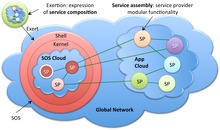SORCER
This article has multiple issues. Please help improve it or discuss these issues on the talk page. (Learn how and when to remove these template messages)
|
| Repository | |
|---|---|
| License | Apache License |
| Official website | sorcersoft |
The service-oriented computing environment (SORCER)
SORCER's predecessor was the federated intelligent product environment (FIPER), which was software for a
Overview
SORCER is a
SORCER is a federated service-oriented platform with a front-end federated

SORCER Operating System
This section needs additional citations for verification. (December 2013) |
The SORCER Operating System (SOS) manages execution of front-end service-oriented mograms[
Applications
The basic exertion-oriented platform[
History
SORCER follows up on the FIPER project (1999-2003) - funded by
Since 2008 M. Sobolewski continues his SORCER applied research at the Multidisciplinary Science and Technology Center, Air Force Research Laboratory/WPAFB[9][failed verification] and starting in 2010 simultaneously at the Polish Japanese Institute of Information Technology.[citation needed] In 2010 the SORCER Laboratory became an independent research organization focused on the development federated service-oriented computing.[citation needed]
Since 2013 the development of SORCER is continued simultaneously by Sorcersoft.com in cooperation with the Polish-Japanese Institute of Information Technology and SMT Software.[citation needed]
Notes
- ^ Written as SOCER in some early sources.
- ^ "About SORCER Lab at TTU CS". Retrieved 15 December 2013.
- ^ "About SORCER: Timeline". Retrieved 15 December 2013.
References
- ISBN 978-953-7619-51-0. Retrieved 2010-01-27.
- ^ Thompson, Ernest D (2012). "Incorporation of computational fluid dynamics into flight vehicle preliminary design". University of Dayton, 2012. University of Dayton. pp. 230–241.
- ^ Goteng, Gokop (2009). "Development of a Grid Service for Multi-objective Design Optimisation" (PDF). School of Applied Sciences, 2009. Cranfield University.
- ^ Rubach, Paweł (2010-11-16). "Optimal Resource Allocation in Federated Metacomputing Environments" (PDF). Ph.D. Dissertation. Warsaw University of Technology, Faculty of Electronics and Information Technology.
- .
- ISBN 978-1-62410-117-5.
- ISBN 978-1-62410-079-6.
- ISBN 978-1-62410-019-2.
- ^ ISBN 978-1-61499-301-8.
- ISBN 978-1-60086-930-3.
- ISBN 978-1-62410-019-2.
- S2CID 18541033.
- S2CID 21843494.
- ^ ZHANG, Rui-hong; LI Nan; CHA Jian-zhong; LU Yi-ping (2008). "Engineering Collaborative Design Environment Based on Service-oriented Architecture". JOURNAL OF HEBEI UNIVERSITY OF TECHNOLOGY, Vol.37 No.4. pp. 40–44.
- ^ 孔令军, (Kong Lingjun) (2013-06-01). "云制造环境下的设计资源服务化方法研究". Research on servitization method of design resources in the cloud manufacturing environment. 北京交通大学 (Beijing Jiaotong University) Ph.D. Dissertation.
- ^ Aithala, Karkada Nagesha (2011). "A Collaborative Computational Framework for Multidisciplinary and Reliability-based Analysis and Optimization Using SORCER". Wright State University, 2011. Wright State University.
- ^ "ATP Project Brief - 99-01-3079". jazz.nist.gov. Archived from the original on 25 April 2001. Retrieved 13 January 2022.
- ^ Michael Sobolewski, Marquis Who's Who
- ^ "The Computer Science Alumni Newsletter - SORCER" (PDF). 13 (1). Texas Tech University. Fall 2002: 1.
The Laboratory for Service-Oriented Computing EnviRonment (SORCER), headed up by Mike Sobolewski, is an interdisciplinary laboratory at the Computer Science Department at Texas Tech University.
{{cite journal}}: Cite journal requires|journal=(help) - ^ "Agreementfor Collaborative Research on SCoDProjectbetweenBeijingJiaotongUniversity(BJTU) and TexasTechUniversity (TTU)" (PDF). Texas Tech University. July 2007. Retrieved 14 December 2013.
- ^ "TheAgreement signed for Collaborative Research CoSEA Project between Beihang University @UAA) and TexasTech University(TTII)" (PDF). 30 March 2007. Retrieved 14 December 2013.
- ^ "Agreementfor Collaborative Research on SCoDProjectbetweenBeijingJiaotongUniversity(BJTU) and TexasTechUniversity (TTU)" (PDF). 9 July 2007. Retrieved 14 December 2013.
